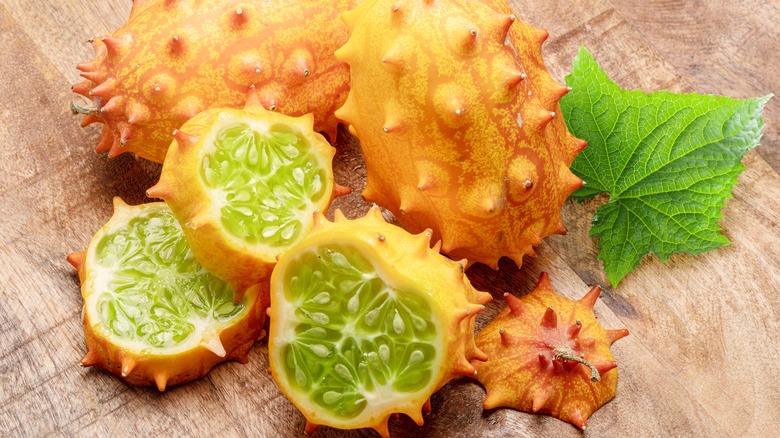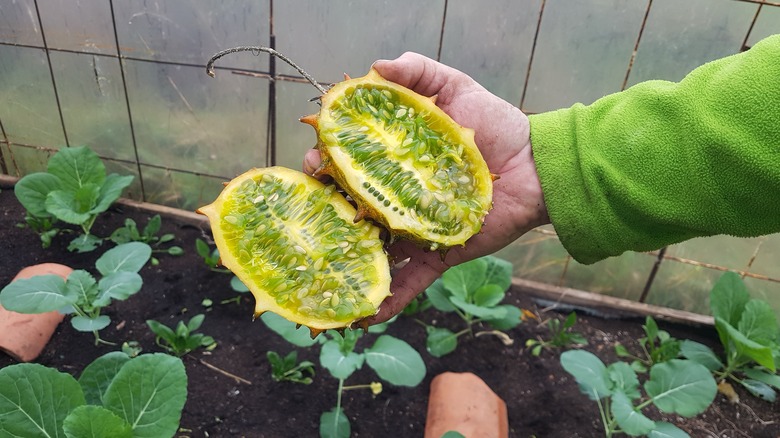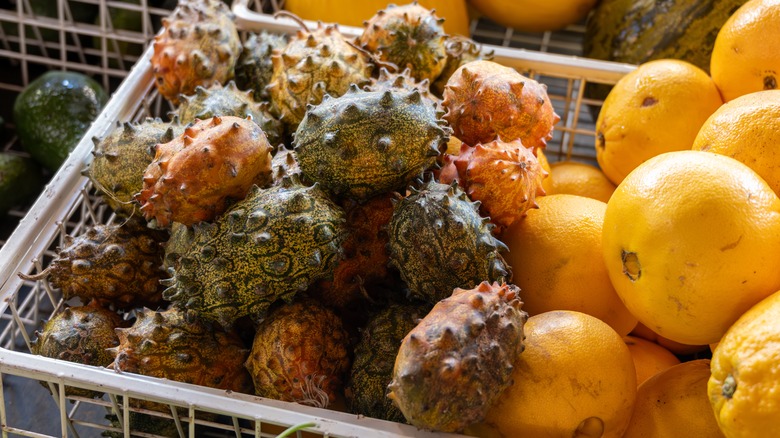What Does A Kiwano Melon Taste Like And Can You Eat The Skin?
The fact of the matter is, our mainstream grocery stores offer us just a tiny fraction of the entire vast world of produce options Mother Nature provides. Within a typical produce section selection, you'll likely always have your apples, oranges, plums, pears, grapes, and maybe some melons or berries, and depending on where you live, that may be just about it. And by and large, you can expect to find the same maybe ten or so options from coast to coast, at least here in the United States, without many newcomers or lesser known fruits such as the kiwano melon, or horned melon, as it's often called.
You likely won't spot the kiwano melon at your local retailer, which means you've missed out on the gorgeous presentation, juicy sweet interior, and health benefits the fruit, a spiky, bright gold, cucumber-looking creation, can provide. For those uninitiated, the look of the fruit is wild and exotic, but the inside taste is quite mild. The flavor is similar to a cucumber, with just a hint of sweetness to the juicy, jelly-like, seed-filled interior — which also looks similar to that of a cuke. The insides are versatile in a wide variety of dishes and applications. The unapproachable-looking spiky skin is technically edible too, but tough, so you may prefer to stick to the easier-to-eat interior.
Kiwano and cucumbers are close cousins
Bright yellow-gold, horned with jumbo spikes, swirly patterns on the skin — the fruit looks almost like the surface of the sun, and certainly you might not connect it to the common cucumber at first glance. But the two are close cousins, in spite of how different they look on the outside. Both are members of the cucurbit family, which also contains gourds, squashes, pumpkins, and melons that grow in warm climates.
The flesh of a cucumber tastes watery and mild, and kiwano is similar, but can err a bit sweeter or brighter — with a hint of limey-tang. Some people further wake up the flavor by sprinkling it with salt, just like watermelon. The seeds are fully edible — thank goodness, because the insides are packed with far too many to attempt to remove them. They pack a bit of a bite and chewy texture against the soft, jelly-like center.
Much like you can eat the skin of a cucumber, but will need to scrape off the tiny pricks from the outside (if you've ever grown your own, you know), the much more substantial spikes of the kiwano need to go before you delve in for easy handling, and especially if you're eating the skin. You can slice the peeled or de-spiked fruit, scoop out just the insides, add into a smoothie for a boost of extra vitamins C, B, and magnesium, or make into a homemade frozen treat using an ice cream machine.
Native to Africa, kiwanos are becoming widespread
You've likely never stumbled across a kiwano at your local store or farmer's market, because the fruit is only readily available in certain pockets of the world — but its availability is growing. The melon hails from Africa, often relied upon for the diets of those in the deserts of Southern Africa, but has spread to numerous countries across Southern and Central Africa, and made its way to New Zealand, Australia, Europe, and even in some parts of the U.S. now — like California.
If you find yourself lucky enough to score a melon or two, no need to treat it with any special kid gloves; the fruit can stay out on the countertop — don't store the produce in your refrigerator drawer. You'll know the flesh is ripe and ready to scoop into when the outer rind gains its signature yellow-orange hue — before that, it'll be green. Much like an avocado, when squeezed, it shouldn't be rock hard, but should give slightly in your hand when squeezed, and be free of any bruises, which occur when it's overripe. Look for these signs and you'll know the melon is perfect and ready to savor.


